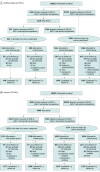Mental Health Care Support in Rural India: A Cluster Randomized Clinical Trial
- PMID: 39141372
- PMCID: PMC11325245
- DOI: 10.1001/jamapsychiatry.2024.2305
Mental Health Care Support in Rural India: A Cluster Randomized Clinical Trial
Abstract
Importance: More than 150 million people in India need mental health care but few have access to affordable care, especially in rural areas.
Objective: To determine whether a multifaceted intervention involving a digital health care model along with a community-based antistigma campaign leads to reduced depression risk and lower mental health-related stigma among adults residing in rural India.
Design, setting, and participants: This parallel, cluster randomized, usual care-controlled trial was conducted from September 2020 to December 2021 with blinded follow-up assessments at 3, 6, and 12 months at 44 rural primary health centers across 3 districts in Haryana and Andhra Pradesh states in India. Adults aged 18 years and older at high risk of depression or self-harm defined by either a Patient Health Questionnaire-9 item (PHQ-9) score of 10 or greater, a Generalized Anxiety Disorder-7 item (GAD-7) score of 10 or greater, or a score of 2 or greater on the self-harm/suicide risk question on the PHQ-9. A second cohort of adults not at high risk were selected randomly from the remaining screened population. Data were cleaned and analyzed from April 2022 to February 2023.
Interventions: The 12-month intervention included a community-based antistigma campaign involving all participants and a digital mental health intervention involving only participants at high risk. Primary health care workers were trained to identify and manage participants at high risk using the Mental Health Gap Action Programme guidelines from the World Health Organization.
Main outcomes and measures: The 2 coprimary outcomes assessed at 12 months were mean PHQ-9 scores in the high-risk cohort and mean behavior scores in the combined high-risk and non-high-risk cohorts using the Mental Health Knowledge, Attitude, and Behavior scale.
Results: Altogether, 9928 participants were recruited (3365 at high risk and 6563 not at high risk; 5638 [57%] female and 4290 [43%] male; mean [SD] age, 43 [16] years) with 9057 (91.2%) followed up at 12 months. Mean PHQ-9 scores at 12 months for the high-risk cohort were lower in the intervention vs control groups (2.77 vs 4.48; mean difference, -1.71; 95% CI, -2.53 to -0.89; P < .001). The remission rate in the high-risk cohort (PHQ-9 and GAD-7 scores <5 and no risk of self-harm) was higher in the intervention vs control group (74.7% vs 50.6%; odds ratio [OR], 2.88; 95% CI, 1.53 to 5.42; P = .001). Across both cohorts, there was no difference in 12-month behavior scores in the intervention vs control group (17.39 vs 17.74; mean difference, -0.35; 95% CI, -1.11 to 0.41; P = .36).
Conclusions and relevance: A multifaceted intervention was effective in reducing depression risk but did not improve intended help-seeking behaviors for mental illness.
Trial registration: Clinical Trial Registry India: CTRI/2018/08/015355.
Conflict of interest statement
Figures


References
-
- Gururaj G, Varghese M, Benegal V, et al. National mental health survey of India, 2015-16. Accessed February 20, 2024. https://indianmhs.nimhans.ac.in/phase1/Docs/Summary.pdf
Publication types
MeSH terms
Grants and funding
LinkOut - more resources
Full Text Sources
Medical
Miscellaneous

